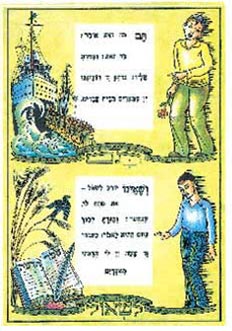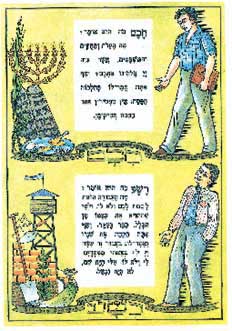

| Socialist Zionism: Tzvi Livni (Israel, 1955) |
This Haggadah
expresses the newly triumphant Zionist socialist pioneering spirit of
the early years of the State of Israel. Unlike medieval haggadot, the
four children are actually children — young
adolescents. Israeli Zionism placed an inordinate emphasis on the young
who would sweep away the old ways. Therefore the hearts and minds of the
adolescent generation must be won over to ideologically motivated pioneering.
In each drawing the questioning child is juxtaposed to the parental answer
portrayed by the objects displayed.
|
•
|
The wise child who still holds the traditional symbol, the book, is dressed as a pioneering member of the Kibbutz. His answer follows roughly the traditional answer: "Tell the wise son the laws of Pesach." Yet these Jewish symbols may also be understood in a nationalist spirit: The menorah is the symbol of the State of Israel, the ten commandments are the moral common denominator of Jews and the Pesach plate symbolizes national historical memory. Most anomalous is the lulav which belongs ritually to Sukkot, not Pesach. It may well symbolize the agricultural revival of the land of Israel so central to Zionist socialist ideology and so glaringly absent from the traditional seder. Generally the answer to the wise child represents not a rebellion against Jewish tradition, but its accommodation to the spirit of modern Jewish nationalism. |
| • | The wicked child is the city slicker "gussied up" with a fancy handkerchief and a tie. His cynical question, "What is all this avodah to you?", is reinterpreted. While avodah in the traditional Haggadah refers to "services," the "cultic" rites of the seder, here it is translated as pioneering "agricultural" work, of making the desert bloom along with the military defense of the land represented by the towers. Towers and stockades were built overnight in the illegal settlements erected by the Zionists in the late 1930s in defiance of the British colonial government. |
| • | The simple child wonders about mass immigration to Israel typical of the 1950s when the population doubled. He is answered by the traditional and the modem Haggadah: "God brought us out of Egypt, out of the house of bondage." Zionists felt they were reliving the original exodus. |
| • | The child who does not know how to ask is ironically and pointedly the anti-Zionist Orthodox child with peot (sidelocks). While in the medieval iconography he would have been the epitome of the wise and observant child, here he is demoted to "ignorant child," knowing nothing of the flora and fauna of Eretz Yisrael and of the "book of knowledge" of Jewish national history and general education. The artist regards it as a matter not of age or of personality but of indoctrination that the most traditional child is least able to ask questions about the changing world around him. |